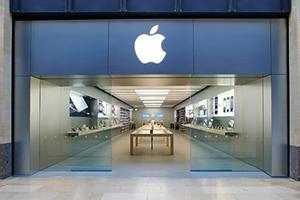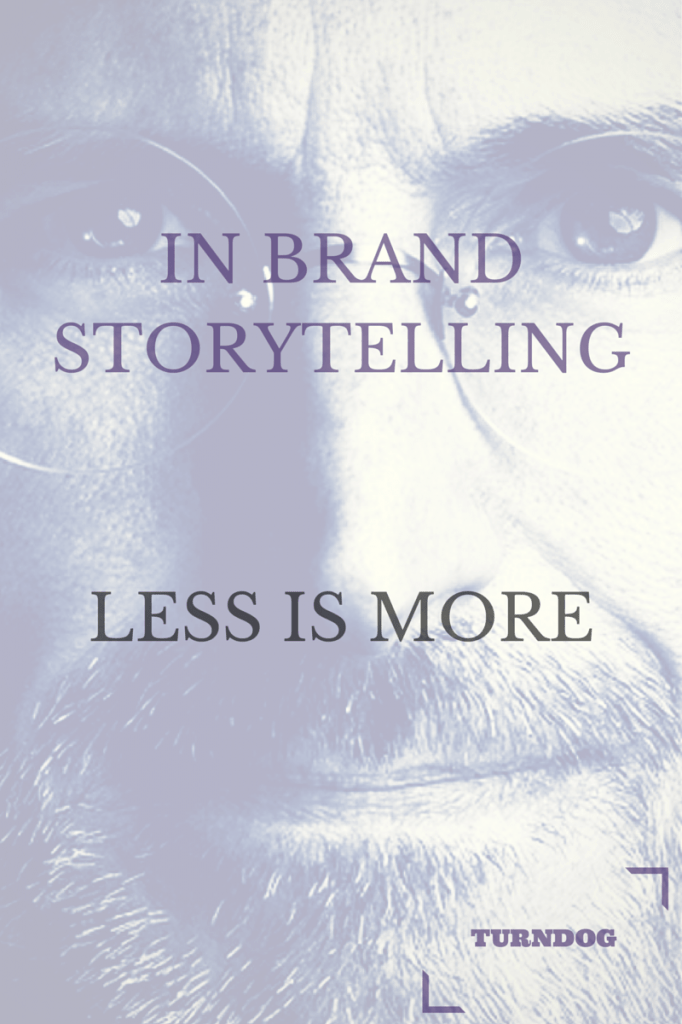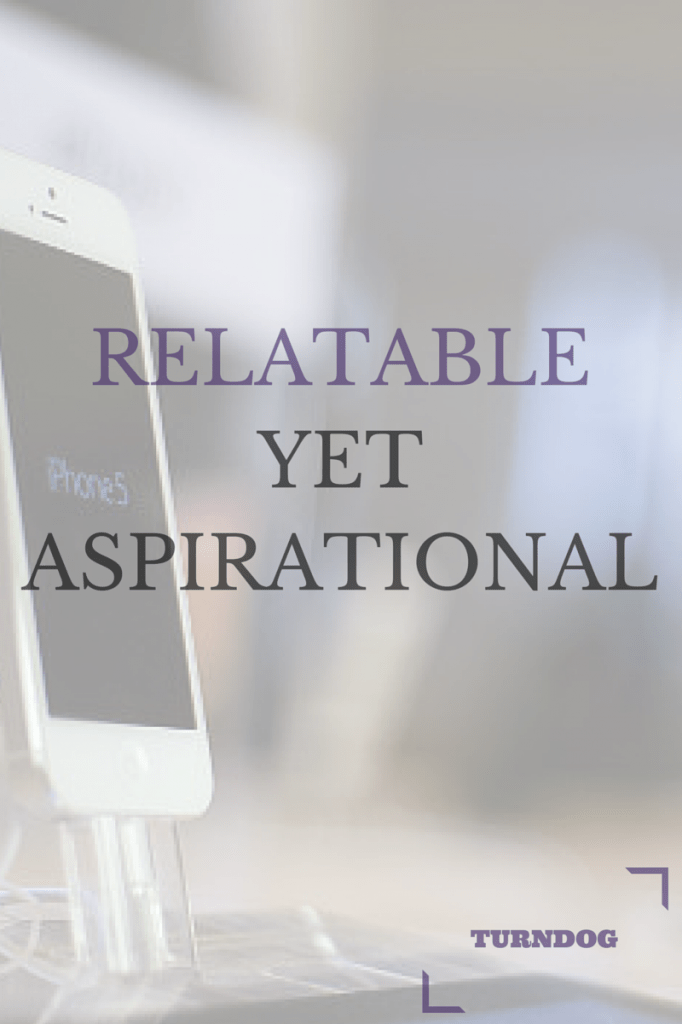It should be no surprise we consider Apple the Top Storytelling Brand in the world. When it comes to emotional journeys, and crafting rabid and deep-meaning relationships, few do it better than Apple – a company that doesn’t invent a damn thing, but builds excitement better than any other. But how do they do it? What storytelling techniques do they use to hook us and immerse us and keep us coming back for more?
Are their phones better than Samsung’s?
Are their laptops worth the price tag compared to Microsoft?
Will their new watch capture our imagination, where other multinationals have failed?
In fact, how the hell did they turn the iPad into a must have, despite entering the market several years late?
Their success isn’t 100% down to storytelling and their storytelling techniques, because they do happen to reinvent the wheel rather well, provide features everyday people crave, and focus on quality better than most of their competitors. They’re a great company, and although many people hate them, few can deny them kudos. BUT despite this, their actual products – on paper – aren’t much better than their competition, and often come up short.
So, how do they do it? Through killer storytelling, that’s how. I could write an entire book about Apple’s storytelling techniques, but today I’ll focus on a mere three, and they happen to be the kind of storytelling techniques we can all utilise.
But before we do, let’s focus on one man – a man I love and admire – a man we can’t replicate, because there’s only one…
STEVE JOBS
I admit, I’m a huge Apple fan. I couldn’t imagine owning a laptop or phone that doesn’t house the famous fruit of my loins (aka: that glowing apple icon). I’m not the type of Apple fanboy to sit outside the store at 3am, awaiting the latest gadget. My love’s deep, but not enough to forgo sleep.
I love Apple, but this isn’t the reason I write about them today. I do so, because I believe they embrace storytelling better than most, and although they have a huge budget, for the most part they don’t need it or use it. This is key, because it demonstrates the power of storytelling – not just the for big boys with millions in the bank.
In my opinion, this all began with a single man. I don’t think Steve Jobs intended to build Apple around storytelling, but the fact remains he was a masterful storyteller, and because of this, he built trust and meaning and excitement. If you’ve watched the Steve Jobs film, or a documentary about him, or read a book about his ways, you’ll know he had a certain aura about his person.
Although rather standoffish, he forever made people lean in. This ability to make people lean in is an important storytelling technique. We can teach it, but most great storytellers simply have it. They have a certain swagger about them, a certain x-factor that stops people in their tracks.
For me, Steve Jobs had this, and it’s why Apple Keynotes have become one of the most anticipated events of the year.
He shared stories, invited people into the journey, and most important of all, dug into their inner feelings, worries, and unconscious desires. I don’t think Tim Cook has this ability, nor does Jonny Ives. But Apple – at least for a while – continue to reap from Mr Jobs’ storytelling ways.
I don’t think an Apple Event will ever be the same, and this demonstrates the power of the storyteller – not just the storytelling techniques on show. Apple do posses skills beyond the late and great Jobs, though. I’m about to share three of them, but remember, they’ll only take you so far.
A story’s true power often lies in the storyteller. Maybe that’s you. Maybe it’s your staff. Whoever it is, they’re important. A brand with a great story to share is one thing, but a brand with a great person sharing it… that’s the dream.
UNCOVERING APPLE’S STORYTELLING TECHNIQUES
Apple utilise numerous storytelling techniques in their events, keynotes, adverts, website, and just about everything else they communicate. Their actual products play a part in the story, and I suppose it’s this that sets them apart from most other brands. They don’t use storytelling per se, rather build everything they do around it.
This is an important point, because it isn’t as simple as using storytelling in your marketing activities anymore. Marketers have done this for generations, and those who continue to do so miss the point. Today, it’s about building your culture, message, and entire business around your story.
Apple do this. Brands like Toms Shoes and Virgin do, too. I don’t want you to read this today and assume there’s a flatpack method of storytelling. There isn’t! The below storytelling techniques take you so far, but what sets you apart from everyone else is, embracing YOUR story, and the storytelling techniques available to YOU.
[Tweet “”Apple don’t use storytelling per se, rather build everything they do around it.” –“]
LESS IS MORE
When it comes to storytelling, I’m a firm believer in Less. Is. More.
The truth is, there’s too much stuff in this world. Often when a Brand shares their story, they try share everything in the hope the more they offer, the more sense it will make. It’s like your friend at the pub who keeps elaborating every single point until you drift off into an unconscious slumber.
They don’t understand the point they’re making, or the story they share, so they talk… and talk… and talk.
Compare this to your friend who’s told their story hundreds of times before, and they whittle it off in an instant. Quick. Simple. To the point.
Brands who don’t share their story are left behind, but it’s easy to see those who jump on the bandwagon and don’t do the groundwork. They create a timeline and overbear it with facts and words. They write long paragraphs of text about their founder. Their videos are long and off-point. They don’t understand their story, so they make up for it with lots of info.
Whereas Apple take a minimalistic approach – not just in their communications (advertisements, website, packaging), but their physical products, too.

Remember those iconic iPod adverts? They don’t need words or explanations. This simple graphic tells the entire story.
When you go into an Apple store, everything’s sleek and minimalistic. Their shelves aren’t packed. They space out their display units. There isn’t the clutter of sales desks or posters or signs stating every promotion and product on offer. In some stores, there’s a single table, but this provides everything you need.

But here’s the thing, it isn’t that Apple don’t share a lot of their story. The reason their Less is More Storytelling technique rocks is because they always share their story – in every tiny detail, and during every ticking second.
Everything Apple do – from the portable checkouts their staff have in store, to their minimalistic products, to the website, TV spots, packaging – comes together to share a unified message. This is what good Brand Storytelling entails. It isn’t about directing your audience to a particular page about how you set up your business. Oh no, it’s about immersing them in your story at all times.
Everything Apple do, requires the question: Will this help share our story?
Because of this, a Less is More approach works. They don’t rely on any single aspect, so each tiny detail plays a role, and when all this comes together, you’re left with an impacting, memorable, and immersive story. This is the dream, kid. When it comes to your Brand Story, it isn’t about adding it into your existing communications, rather basing everything you do around it.

RELATABLE YET ASPIRATIONAL
Why do so many people aspire to own the latest Apple gadget?
Most of us need a phone and laptop, so why do we get so excited? Why do we aspire to own Apple products over Microsoft or Samsung? Price plays a role, as does quality. Lots of aspects come together to create this type of desire, but one trait that sets Apple apart, is it’s ability to relate to folk like you and me.
Imagine yourself in an Apple Store for a second, and all those goodies within reach. Do Apple care if you log on and check your email? Do they hide their precious gadgets behind glass, or hound you with sales folk?
No, they let you play and explore and touch. When you buy a new laptop or phone, they encourage you to open the box, set it up, and hold it in your fingertips. They don’t do a damn thing, simply stand to one side and guide. It’s an inviting story, and places you in the moment. They want you to relate with their products, messages, and experiences. By ensuring you relate, they ensure you desire and aspire to own it.
I think the common perception behind building aspiration and desire, is to cloud everything in mystique. After all, this works for brands like Ferrari and Bugatti. But the real forward thinkers of today, invite you into their world and encourage you to touch and fall in love. Apple do this, and so do Tesla – the electric car company who’ve turned the way we sell cars upside down.
Rather than make you stand on the outside, today’s innovative brand storytellers find ways to invite you into the process, and allow you to touch, feel, and relate to the product and service on offer. It’s like Apple are saying to us, “Come in and make yourself comfortable. See how easy it is to use our products, and feel free to hangout as long as you like.”
They don’t sell you anything. They provide everything out in the open and allow time to nurture desire and aspiration within you. But this requires confidence in your greater story, because if you don’t, you’ll always worry about making the sale. But today’s true innovators welcome you with open arms, and because of this, we aspire to own products from the Apple’s and Tesla’s of the world far more than the mainstream rabble.

FOREVER BUILDING ANTICIPATION
Building anticipation is one of the greatest storytelling techniques you can use. I used to love the TV show Lost, and my-oh-my did it leave me on a cliffhanger each time. 24 did this, too, as do movies like The Hunger Games and The Hobbit. Good storytelling leaves you on the edge of your seat – be it through humour, fear, intrigue…
When it comes to building anticipation within Brand Storytelling, look no further than Apple. We discuss their keynotes months beforehand. How on earth has a company that sells electrical equipment put their product launches on the same pedestal as SXSW, Comic Con, and The Oscars?
Apple leave us wanting more every time. I love the iPhone 6, but what about a sapphire screen and waterproofing? We know it’s coming, but when? What will the next Apple product have? When will they release the infamous Apple TV Set? Why did they tease us with the Apple Watch months before it hits the shelves?
Because they’re masters at building anticipation, and transforming everything they do into an event… an experience… a story.
It’s one of the simplest storytelling techniques in the book – leave the audience wanting more… talking about it… unable to forget about it. But how many brands achieve this? How many businesses build this type of excitement and anticipation? Few come to my mind!
By always building anticipation, Apple stay front and centre, and where others seek press and exposure, it comes to Apple whether they want it or not. Theirs is the kind of addictive story we dream about. They’re the hit TV show that leaves us gasping at the end of each episode, and filling internet forums with conspiracy theories and what-might-come-next’s.
If Apple are Lost and Breaking Bad, then companies like Samsung are Everybody Loves Raymond – I mean it’s good, but will you book it in your diary?
If you’re an Apple fan, you know you’re part of an ever-evolving story – whether you like it to not. It’s never about a single product or launch. It’s always about Apple as a brand, and the grander vision on offer. Good Brand Storytelling achieves this, and guides you away from a product and towards the bigger picture.
UNEARTHING APPLE’S UNBELIEVABLE STORYTELLING TECHNIQUES
These are just three storytelling techniques I believe Apple utilise well, but just because they work for them doesn’t mean they will for you. Like I said earlier, it’s about YOU embracing YOUR story, and using the storytelling techniques that help set you apart.
When working with clients, I often begin with PEOPLE. Whether it’s you or your staff, people play a large role. Steve Jobs demonstrates this. His individual journey (setting up Apple before they forced him out, only to invite him back after the s%$t hit the fan), is the kind people relate to. It’s the underdog story. It’s the hero rising form the ashes.
But it isn’t just his individual story. The way he went about his business, and shared information, and invited you to be part of something special… this is what set him apart from his peers (Bill Gates, Tim Cook, most other CEO’s in the world). Steve Jobs had it. Richard Branson has it. Elon Musk has it.
The power of storytelling is strong, but the power of the storyteller, stronger.
[Tweet “The power of storytelling is strong, but the power of the storyteller, stronger ~~”]
And if you don’t happen to be like Steve or Elon or Sir Richard, no problem. I’m not, and it doesn’t stop me from sharing my one-true-story. You have to look at yourself, and those around you, because P.E.O.P.L.E. are the strongest of all storytelling techniques.
Of course, a great storyteller still needs to unveil a great story, and as I think Apple shows, there’s lots of ways to do this. I hope you leave inspired by these storytelling techniques, and relate them to your own business. I’d love to hear your thoughts, so please message me on TWITTER or FACEBOOK and share your opinions. That’s where our conversation can continue, if you wish…

hi, i’m turndog and I wrote this article … i am a writer, ghostwriter, anti-hustler & a guy on a mission to ensure you too escape the hustle — come be part of the [no hustle] movement

